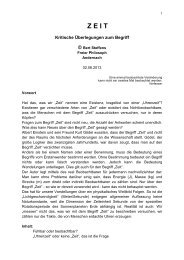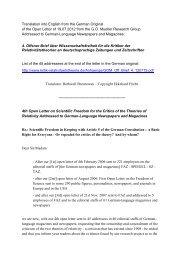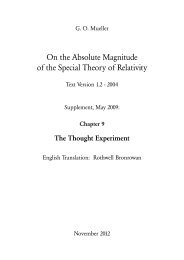2394 weitere kritische Veröffentlichungen - Kritische Stimmen zur ...
2394 weitere kritische Veröffentlichungen - Kritische Stimmen zur ...
2394 weitere kritische Veröffentlichungen - Kritische Stimmen zur ...
Sie wollen auch ein ePaper? Erhöhen Sie die Reichweite Ihrer Titel.
YUMPU macht aus Druck-PDFs automatisch weboptimierte ePaper, die Google liebt.
tivistic' formulae for these two cases have been confirmed<br />
by experiment and are described in many textbooks.<br />
It was, however, not recognized that they are at variance<br />
with Einstein's relativity principle extended to electromagnetic<br />
waves."<br />
S. 31: "In this paper the formulae for the relativistic<br />
Doppler effect are derived without using the Lorentz<br />
transformation (Section II). This can be done in the<br />
photon picture of light in combination with the relativistic<br />
modification of Newtonian mechanics applied to<br />
detector and source. We find indeed different frequency<br />
shifts depending on whether the observer moves or the<br />
source. In Section III these results are compared with<br />
those deduced by Einstein from the Lorentz transformation.<br />
It turns out that there is practical agreement<br />
with the formulae derived in Section II. In Section IV<br />
the conclusion drawn from the Lorentz transformation<br />
that a wave front `appears' tilted, if there is a relative<br />
velocity between observer and source, is scrutinized<br />
and found to be untenable. In Section V consequences<br />
of our analysis for the principle of relativity and for the<br />
Lorentz transformation are discussed."<br />
Liefert mit dem Nachweis, daß die beim Doppler-<br />
Effekt auftretenden Frequenzänderungen abhängig<br />
davon sind, ob sich die Quelle oder der Beobachter<br />
bewegen, eine grundsätzliche Widerlegung des SRT-<br />
Relativitätsprinzips und der Lorentz-Transformationen.<br />
- Diskutiert in Abschnitt IV (S. 41-45) die Stern-<br />
Aberration. Sie konnte schon im 18. Jh. von Bradley<br />
mit Annahme eines Äthers und der Galilei-Transformation,<br />
also ohne Lorentz-Transformation erklärt werden.<br />
Betrachtet 4 verschiedene Konstellationen von<br />
Stern und Teleskop und stellt für die 4 Fälle jeweils die<br />
Behauptung nach der Lorentz-Transformation und die<br />
astronomischen Beobachtungen gegenüber (S. 43), woraus<br />
sich klare Widersprüche ergeben, so daß die Beobachtungen<br />
die Lorentz-Transformation widerlegen.<br />
Weitere Argumente ergeben sich aus der Erörterung der<br />
Doppelsternsysteme.<br />
Engelhardt, Wolfgang 2004<br />
On the relativistic transformation of electromagnetic<br />
fields: received on November 19, 2003 / W. Engelhardt.<br />
In: Apeiron. 11. 2004, No. 2, April, S. 309-326<br />
= http://redshift.vif.com/JournalFiles/V11NO2PDF/<br />
V11N2ENG.pdf - 18 S.<br />
SRT. AE1905. EM-FELDER. LORTF. VOIGT. MAX-<br />
WELL. HIS.<br />
S. 309: "By investigating the motion of a point charge<br />
in an electrostatic and in a magnetostatic field, it is<br />
shown that the relativistic transformation of electromagnetic<br />
fields leads to ambiguous results. The necessity<br />
for developing an `electrodynamics for moving matter'<br />
is emphasized."<br />
S. 311: "In the present paper the concept of special<br />
relativity, namely to substitute an `electrodynamics for<br />
G. O. Mueller: SRT. Kap. 4-Erg.<br />
114<br />
moving bodies' by an `electrodynamics for matter at<br />
rest' combined with a prescription for transforming the<br />
fields, is scrutinized. In Sections III and IV the motion<br />
of a charged particle in an electrostatic and in a magnetostatic<br />
field, respectively, is calculated in two frames<br />
moving at a constant velocity relatively to each other.<br />
Adopting the relativistic expressions for the transformed<br />
fields, we obtain ambiguous results. It turns out that<br />
Einstein's concept is only viable in very singular cases.<br />
It is apparently necessary to develop a true electrodynamics<br />
for moving matter, in general."<br />
Fordert die Formulierung einer wahren "Elektrodynamik<br />
für bewegte Materie", weil der Versuch Albert<br />
Einsteins in der SRT, eine solche Elektrodynamik durch<br />
eine "Elektrodynamik für ruhende Materie" und eine<br />
relativistische Transformation der Felder zu ersetzen,<br />
zu mehrdeutigen Ergebnissen führt, die ohnehin nur für<br />
Spezialfälle, also nicht generell gelten. Albert Einstein<br />
hat also keine wahre Elektrodynamik für bewegte Körper<br />
vorgelegt.<br />
Die Lorentz-Tranformation ist von W. Voigt nur<br />
für den Sonderfall von konstanten Geschwindigkeiten<br />
hergeleitet worden. Albert Einstein hat dagegen angenommen,<br />
daß seine Formeln auch gelten, wenn sich die<br />
Geschwindigkeit ändert in Raum und Zeit, verbunden<br />
mit einer Vorschrift <strong>zur</strong> Transformation der Felder.<br />
S. 324: "From the analysis in Sections III and IV it<br />
became obvious that a solution of `Maxwell's equations<br />
for matter at rest' cannot be made into a solution for<br />
moving matter by applying the Lorentz transformation,<br />
in order to obtain the fields in a moving system. It is<br />
questionable anyway, whether this method would work<br />
when the velocity varies in space and time, since the<br />
Lorentz transformation is restricted to constant motion."<br />
S. 325: "In 1890 Hertz [2] was aware of the fact that<br />
the final forms of the forces are not yet found. In case<br />
the open problems could not be solved, he was not even<br />
certain that Faraday's and Maxwell's field concept is<br />
viable at all. Having shown that the transformation of<br />
the electromagnetic fields, as proposed by special<br />
relativity, is not a feasible concept to establish an `electrodynamics<br />
for moving matter', it is obvious that the<br />
work started by Lorentz [8] and Hertz [3] should be<br />
taken up again, both theoretically and experimentally.<br />
It remains to be seen to what extent classical electrodynamics<br />
will require a basic revision."<br />
Engelhardt, Wolfgang 2009<br />
On the origin of the Lorentz Transformation / W.<br />
Engelhardt. - [Deutschland]: WWW 2009. 6 S.<br />
URL: http://www.worldsci.org/pdf/abstracts/<br />
abstracts_4547.pdf - Status: Kritik. - Quelle: Autopsie.<br />
Textversion 1.2 - 2012





